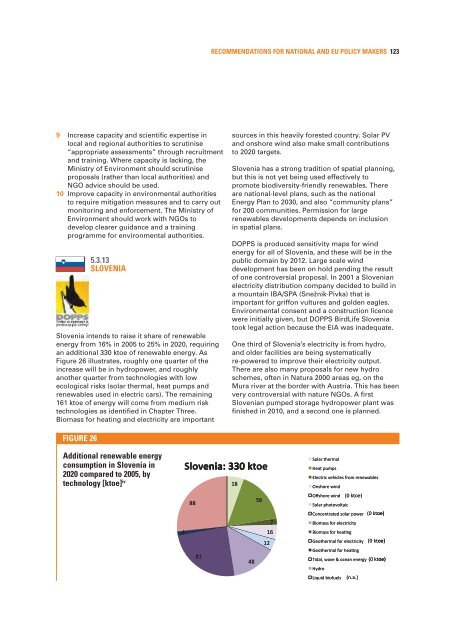Meeting Europe's renewable energy targets in harmony with - RSPB
Meeting Europe's renewable energy targets in harmony with - RSPB
Meeting Europe's renewable energy targets in harmony with - RSPB
Create successful ePaper yourself
Turn your PDF publications into a flip-book with our unique Google optimized e-Paper software.
RECOMMENDATIONS FOR NATIONAL AND EU POLICY MAKERS 123<br />
9 Increase capacity and scientific expertise <strong>in</strong><br />
local and regional authorities to scrut<strong>in</strong>ise<br />
“appropriate assessments” through recruitment<br />
and tra<strong>in</strong><strong>in</strong>g. Where capacity is lack<strong>in</strong>g, the<br />
M<strong>in</strong>istry of Environment should scrut<strong>in</strong>ise<br />
proposals (rather than local authorities) and<br />
NGO advice should be used.<br />
10 Improve capacity <strong>in</strong> environmental authorities<br />
to require mitigation measures and to carry out<br />
monitor<strong>in</strong>g and enforcement. The M<strong>in</strong>istry of<br />
Environment should work <strong>with</strong> NGOs to<br />
develop clearer guidance and a tra<strong>in</strong><strong>in</strong>g<br />
programme for environmental authorities.<br />
5.3.13<br />
SLOVENIA<br />
Slovenia <strong>in</strong>tends to raise it share of <strong>renewable</strong><br />
<strong>energy</strong> from 16% <strong>in</strong> 2005 to 25% <strong>in</strong> 2020, requir<strong>in</strong>g<br />
an additional 330 ktoe of <strong>renewable</strong> <strong>energy</strong>. As<br />
Figure 26 illustrates, roughly one quarter of the<br />
<strong>in</strong>crease will be <strong>in</strong> hydropower, and roughly<br />
another quarter from technologies <strong>with</strong> low<br />
ecological risks (solar thermal, heat pumps and<br />
<strong>renewable</strong>s used <strong>in</strong> electric cars). The rema<strong>in</strong><strong>in</strong>g<br />
161 ktoe of <strong>energy</strong> will come from medium risk<br />
technologies as identified <strong>in</strong> Chapter Three.<br />
Biomass for heat<strong>in</strong>g and electricity are important<br />
sources <strong>in</strong> this heavily forested country. Solar PV<br />
and onshore w<strong>in</strong>d also make small contributions<br />
to 2020 <strong>targets</strong>.<br />
Slovenia has a strong tradition of spatial plann<strong>in</strong>g,<br />
but this is not yet be<strong>in</strong>g used effectively to<br />
promote biodiversity-friendly <strong>renewable</strong>s. There<br />
are national-level plans, such as the national<br />
Energy Plan to 2030, and also “community plans”<br />
for 200 communities. Permission for large<br />
<strong>renewable</strong>s developments depends on <strong>in</strong>clusion<br />
<strong>in</strong> spatial plans.<br />
DOPPS is produced sensitivity maps for w<strong>in</strong>d<br />
<strong>energy</strong> for all of Slovenia, and these will be <strong>in</strong> the<br />
public doma<strong>in</strong> by 2012. Large scale w<strong>in</strong>d<br />
development has been on hold pend<strong>in</strong>g the result<br />
of one controversial proposal. In 2001 a Slovenian<br />
electricity distribution company decided to build <strong>in</strong><br />
a mounta<strong>in</strong> IBA/SPA (Snežnik-Pivka) that is<br />
important for griffon vultures and golden eagles.<br />
Environmental consent and a construction licence<br />
were <strong>in</strong>itially given, but DOPPS BirdLife Slovenia<br />
took legal action because the EIA was <strong>in</strong>adequate.<br />
One third of Slovenia’s electricity is from hydro,<br />
and older facilities are be<strong>in</strong>g systematically<br />
re-powered to improve their electricity output.<br />
There are also many proposals for new hydro<br />
schemes, often <strong>in</strong> Natura 2000 areas eg, on the<br />
Mura river at the border <strong>with</strong> Austria. This has been<br />
very controversial <strong>with</strong> nature NGOs. A first<br />
Slovenian pumped storage hydropower plant was<br />
f<strong>in</strong>ished <strong>in</strong> 2010, and a second one is planned.<br />
FIGURE 26<br />
Additional <strong>renewable</strong> <strong>energy</strong><br />
consumption <strong>in</strong> Slovenia <strong>in</strong><br />
2020 compared to 2005, by<br />
technology [ktoe] iv
















